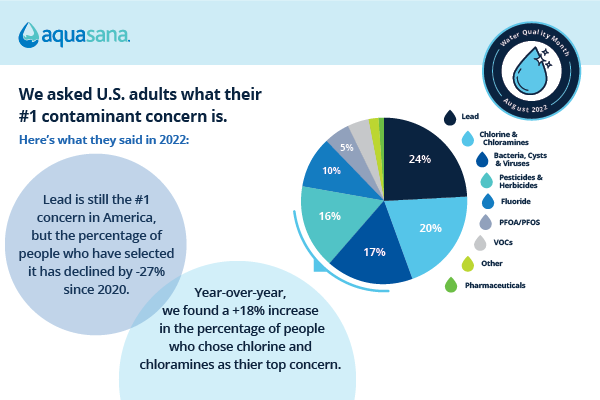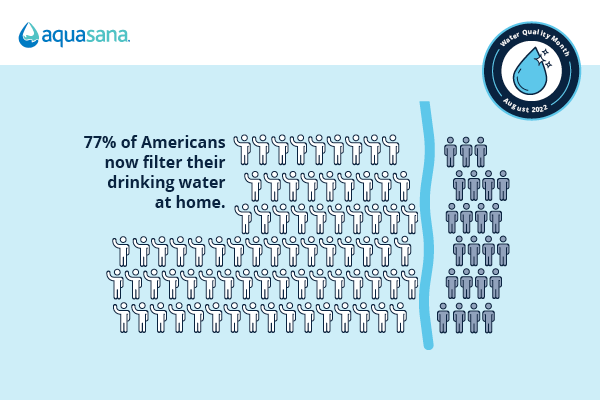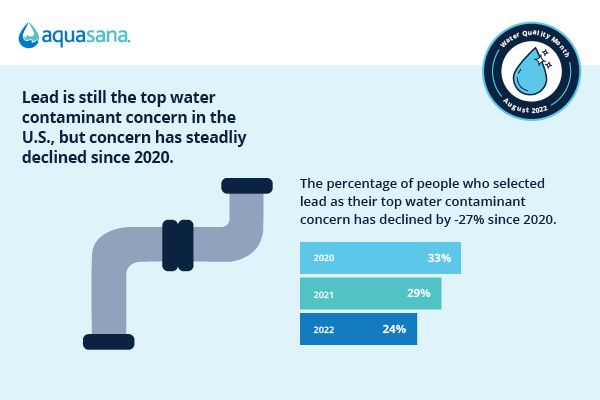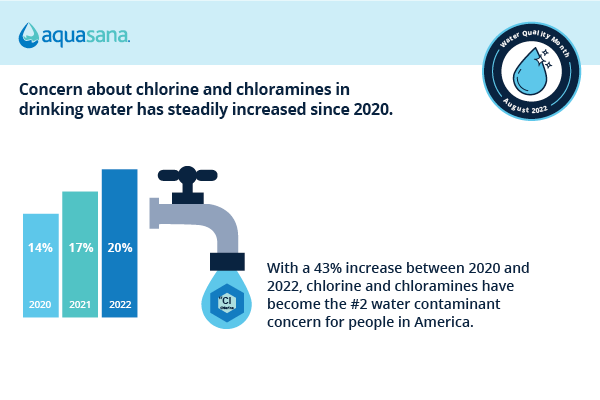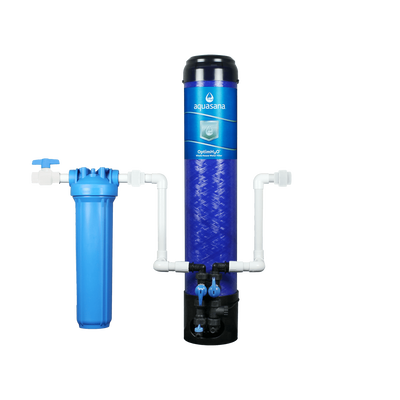These chemicals are commonly used during the water treatment process to disinfect it, but come with dangers that Americans may be gaining awareness of. For context, here’s some information about chlorine and chloramines and the difference between them:
- Chlorine: The long-time primary disinfectant of water. Unfortunately, chlorine has downsides including the creation of harmful byproducts when dirt and germs react with it, an effect on taste and smell, and a lack of staying power which gives bacteria found in pipes a chance to reinfect water as it passes from a treatment facility to a tap.
- Chloramines: Chloramines are a solution of 5-parts chlorine and 1-part ammonia that have been in use since the 1930s, but in the last decade many cities have switched from chlorine to chloramines because they’re seen as a more effective disinfectant alternative. Compared to chlorine, chloramines produce lower levels of byproducts, have a lesser effect on water taste and odor, and remain in tap water for a longer period to ward off other toxins.
However, the added staying power of chloramines does come with a few downsides. The trace amount of chemicals that remain can cause irritation in your skin, hair, and eyes — an issue that’s especially prominent when showering in an enclosed space where you may inhale vaporized chloramine. Furthermore, these chemicals also pose a risk to kidney dialysis patients, fish owners, and there may still be a slight unpleasant taste or odor from the chemical’s presence.
As more and more cities switch from the use of chlorine to chloramines, concern may grow over the latter’s harmful side effects.
3. Bacteria, Cysts & Viruses
Rounding out the top three contaminant concerns in 2022 — bacteria, cysts, and viruses received 17% of the vote and saw a year-over-year decrease relative to our last survey. The contaminant had a 19% vote share in 2020, then jumped to 24% in 2021 in correlation with the COVID-19 pandemic, but dipped down to 17% this year. Despite the decrease, the pandemic remains top of mind for Americans who selected this as their top concern — as 40% of people who chose it said “the COVID-19 pandemic made me more concerned about bacteria, cysts, and viruses being in my water.”
2021 vs. 2022: Changes in Why People are Filtering Their Drinking Water
We know that water filtration is becoming more popular over time, but what reasons are driving these changes? To understand this trend, we asked people who currently filter their water about their reason for doing so. Take a look at the results below, and read more detailed findings on the top three answers in the following sections.
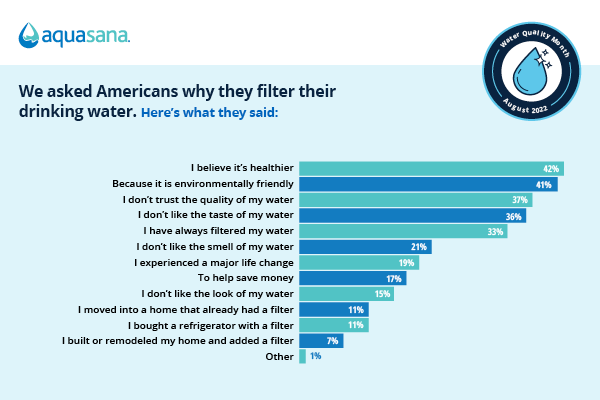
As people prioritized their health during the pandemic, we’ve seen significant habit and lifestyle changes. Beyond wearing masks and social distancing, it appears that people also started to look for ways to improve the safety of their tap water – and water filters are a clear and effective solution.
Regarding health, proper hydration is essential for keeping your body in good condition. However, not all water is equally as beneficial. Drinking contaminated water puts your health at risk, so one could argue that using clean, filtered water is just as important as the act of hydration itself.
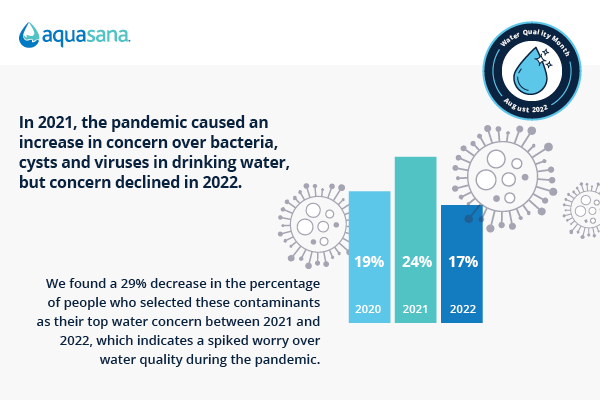
1. Health: In a post-COVID-19 world, health is more important to Americans than before and it’s impacting water filtration habits
The link between health and water is intrinsic, so it’s no surprise this is the top reason people filter their water, but we’ve also found that in a post-COVID-19 world health is top of mind more than ever.
Our survey revealed more than half of Americans (54%) agree they are more concerned about their health because of the pandemic, and that 40% of Americans are now more concerned about the quality of the unfiltered water in their homes because of COVID-19.
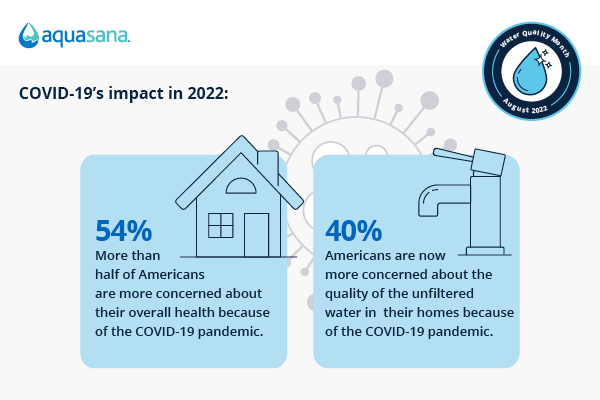
2. Environment: The environment is top of mind for people who filter their water
At 41%, the environment was the second most commonly selected reason why people filter their drinking water and it was very close behind health.
American concern regarding the environment has grown over time, as an annual Gallup poll found that many consider the seriousness of global warming to be underestimated in the news. In 1998, 34% of the population believed the seriousness of global warming is generally correct while 27% noted it was being underestimated. In 2022, only 21% of the population believes the seriousness of global warming is generally correct while 40% now believe it’s being underestimated. Furthermore, the same poll found that in 2022, 59% of the population believes the quality of the environment in the U.S. is getting worse.
As a result of growing concern for the environment, consumer habits have also changed in favor of eco-friendly products. According to 2021 survey data from The Economist, 72% of respondents reported they are actively buying more environmentally friendly products than they did five years ago and 81% noted they expect to buy even more over the next five years. Similarly, our survey found that in 2022, 45% of people say they “always” seek out products to purchase because they are sustainable for the environment, which is up from 27% in 2021.
This change is referred to as the “Eco-wakening”, and its effects are far-reaching with no signs of slowing down.
As for why people are purchasing water filters to help the environment, one key reason is that water filters are a far more eco-friendly alternative to plastic bottles. In our recent article on plastic bottles, we found that the average American uses 167 disposable bottles per year, 80% of them end up in landfills, and they take 450 years to decompose. Switching from plastic bottles to a water filter helps the environment; in fact, in 2019 our water filtration systems displaced over 1.2 billion single-use plastic bottles.
As consumers look for ways to help the environment in their purchasing decisions, switching from bottled water to a filter is a clear and obvious choice. Beyond the environmental benefits, it’s also cost-effective, as drinking the recommended 8 glasses of water per day would cost $1,400 per year from bottles.
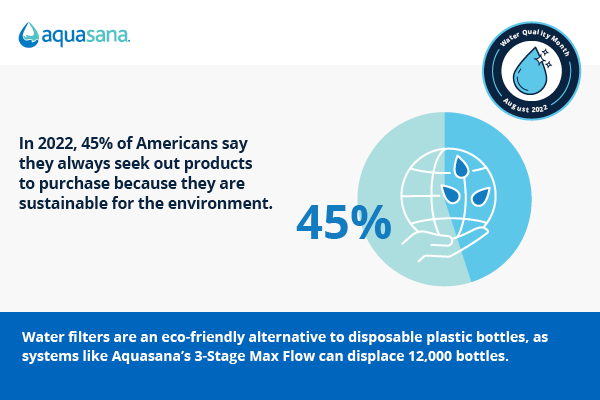
3. Water Quality: Americans are turning to water filters for trusted water
At 37%, lack of trust in the quality of drinking water is the third highest motivation for people who filter. Even if consumers rely on public tap water that’s frequently tested and treated by the city, consumers may not be satisfied with environmental standards on the level of contaminants that are allowed to be in water. Even after water has been treated — there’s still a risk for recontamination as it travels from the treatment facility through water lines to homes.
Of the population who doesn’t filter their water, trust was also the most common reason people noted they would start. We asked people who don’t filter their drinking water what situations would motivate them to start, and “if I couldn’t trust the quality of my water” was selected 65% of the time.
Trust is tied closely with knowledge, and year-over-year — we found an increase in people who say they know a lot about the quality of their water, as well as an increase in people who are concerned about the quality of their drinking water. In 2022, 27% of people said they know a lot about the quality of their unfiltered tap water at home, which was a 59% increase from last year (17% to 27%). In correlation with an increase in knowledge, we also saw a rise in concern. In 2022, 51% of our survey respondents said they are concerned with the quality of unfiltered tap water in their homes, a 50% increase from 2021 (34% to 51%).
These findings suggest that people are learning more about their water quality, but this may be leading to less trust in it.
In fact, this year 69% of people agree it’s necessary to filter their tap water at home, which is up from 63% in 2020. On the same note, more than half (53%) of people selected a filtered water source as the most trustworthy option for clean drinking water in 2022.
This accounts for the combined results of several types of filters (whole house, under sink, etc.), although the highest standalone answer was bottled water with 31% of the vote. But as should be expected, trust in bottled water has gone down over time, from 41% of people rating it as the most trustworthy source in 2020 to 39% in 2021 and a staggering drop to 31% this year.
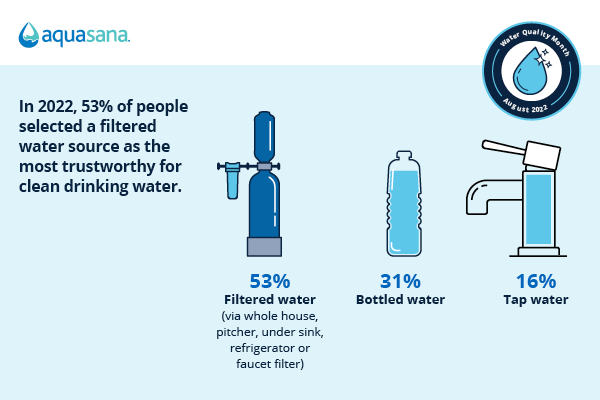
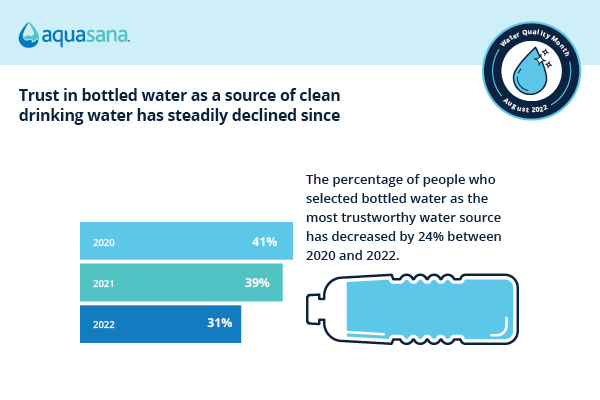
Beyond the environmental negatives mentioned earlier, bottled water may actually be less safe than even non-filtered tap water because bottle manufacturers don’t have as stringent regulations as local municipalities. Bottled water manufacturers are not required to disclose where the water came from, how it was treated, and what contaminants it contains. As consumers become more knowledgeable about water quality, they appear to be recognizing that bottled water isn’t as safe as it’s sometimes talked about.
Key Takeaways From Our Survey Results
More and more Americans are choosing to filter their tap water at home. The primary contaminant concerns have remained the same in recent years, though we’ve seen heightened concern about chlorine and chloramines. When looking at motivations for filtering water, we found the driving factors are health, concern for the environment, and a lack of trust in their water quality fueled by growing knowledge of the subject.
Moving forward, data suggests we will continue to see a steady increase in the popularity of water filters and decreased trust in disposable bottles.
Survey Methodology and Definitions
The findings presented in this article are the result of a March 2022 study of 2,246 U.S. adults, conducted by Aquasana. (Confidence Level: 95%, Margin of Error: 2%)
Demographic Definitions
Age Cohorts (based on Pew Research)
- Baby Boomers: 1946-64
- Gen X: 1965-80
- Millennials: 1981-96
- Gen Z: 1997-2012
Regions (based on U.S. Census map)
- Northeast: Maine, Massachusetts, New Hampshire, New Jersey, New York, Pennsylvania, Rhode Island, Vermont, Connecticut
- Midwest: Illinois, Indiana, Iowa, Kansas, Michigan, Minnesota, Missouri, Nebraska, North Dakota, Ohio, South Dakota, Wisconsin
- South: Alabama, Georgia, Kentucky, Louisiana, Maryland, Mississippi, North Carolina, Oklahoma, South Carolina, Arkansas, Tennessee, Texas, Virginia, West Virginia, Delaware, Florida
- West: Idaho, Alaska, Montana, Nevada, Arizona, New Mexico, Oregon, Utah, Washington, Wyoming, California, Colorado, Hawaii
Urban, Suburban, and Rural classifications were self-reported.
